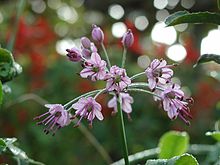| Chinese onion | |
|---|---|

| |
| Scientific classification | |
| Kingdom: | Plantae |
| Clade: | Tracheophytes |
| Clade: | Angiosperms |
| Clade: | Monocots |
| Order: | Asparagales |
| Family: | Amaryllidaceae |
| Subfamily: | Allioideae |
| Genus: | Allium |
| Subgenus: | A. subg. Cepa |
| Species: | A. chinense
|
| Binomial name | |
| Allium chinense | |
| Synonyms[2] | |
|
Synonymy
| |
Allium chinense (also known as Chinese onion,[3][4] Chinese scallion,[3] glittering chive,[5] Japanese scallion,[3] Kiangsi scallion,[4] and Oriental onion[3]) is an edible species of Allium, native to China,[3] and cultivated in many other countries.[6] Its close relatives include the onion, scallion, leek, chive, and garlic.[7]

Distribution[edit]
Allium chinense is native to China (in Anhui, Fujian, Guangdong, Guangxi, Guizhou, Hainan, Henan, Hubei, Hunan, Jiangxi, and Zhejiang provinces).[3] It is naturalized in other parts of Asia as well as in North America.[3][8][9]
Uses[edit]
Culinary[edit]
Owing to its very mild and "fresh" taste, A. chinense is often pickled and served as a side dish in Japan and Vietnam to balance the stronger flavor of some other component in a meal. For example, in Japanese cuisine, it is eaten as a garnish on Japanese curry.[10]
In Vietnam, pickled A. chinense, known as củ kiệu, is often served during Tết (Lunar New Year).[citation needed]
In Japanese, it is known as rakkyō (辣韮 or 薤). Glass bottles of white rakkyō bulb pickles are sold in Asian supermarkets in North America.[11]
Medicinal[edit]
Allium chinense is used as a folk medicine in tonics to help the intestines, and as a stomachic.[12]
See also[edit]
- Allium tuberosum, also known as garlic chives – Species of onion native to southwestern parts of the Chinese province of Shanxi
- Pickled onion – Onions pickled in a solution of vinegar or salt
References[edit]
- ^ Brummitt, N. (2013). "Allium chinense". IUCN Red List of Threatened Species. 2013: e.T44392537A44396666. doi:10.2305/IUCN.UK.2013-2.RLTS.T44392537A44396666.en. Retrieved 18 November 2021.
- ^ a b "Allium chinense". World Checklist of Selected Plant Families. Royal Botanic Gardens, Kew. Retrieved 2013-05-28.
- ^ a b c d e f g "Allium chinense". Germplasm Resources Information Network. Agricultural Research Service, United States Department of Agriculture. Retrieved 2017-12-15.
- ^ a b Multilingual Multiscript Plant Name Database: Allium. University of Melbourne. Updated 3 August 2013. Retrieved 5 September 2014.
- ^ English Names for Korean Native Plants (PDF). Pocheon: Korea National Arboretum. 2015. p. 347. ISBN 978-89-97450-98-5. Archived from the original (PDF) on 25 May 2017. Retrieved 17 December 2016 – via Korea Forest Service.
- ^ Flora of China Vol. 24 Page 196 藠头 jiao tou Allium chinense G. Don, Mem. Wern. Nat. Hist. Soc. 6: 83. 1827.
- ^ Block, E. (2010). Garlic and Other Alliums: The Lore and the Science. Royal Society of Chemistry. ISBN 978-0-85404-190-9.
- ^ "Allium chinense Rakkyo PFAF Plant Database". pfaf.org. Retrieved 2021-11-10.
- ^ USDA, NRCS (n.d.). "Allium chinense". The PLANTS Database (plants.usda.gov). Greensboro, North Carolina: National Plant Data Team. Retrieved 7 June 2022.
- ^ "Japanese beef curry (Curry Rice)". JustHungry. 2007-02-06. Archived from the original on 2007-02-08. Retrieved 2021-11-10.
- ^ "Niitakaya Rakkyo". Asia Mart, Santa Rosa. Archived from the original on 2021-12-02. Retrieved 2023-06-24.
- ^ James A. Duke. "Allium chinense (LILIACEAE)". Dr. Duke's Phytochemical and Ethnobotanical Databases. Retrieved 2017-12-15.

Well, that’s interesting to know that Psilotum nudum are known as whisk ferns. Psilotum nudum is the commoner species of the two. While the P. flaccidum is a rare species and is found in the tropical islands. Both the species are usually epiphytic in habit and grow upon tree ferns. These species may also be terrestrial and grow in humus or in the crevices of the rocks.
View the detailed Guide of Psilotum nudum: Detailed Study Of Psilotum Nudum (Whisk Fern), Classification, Anatomy, Reproduction